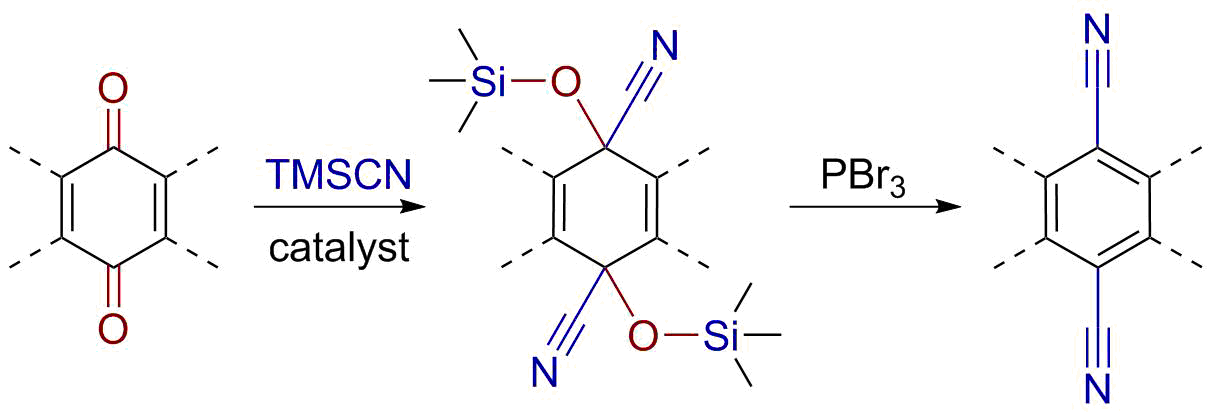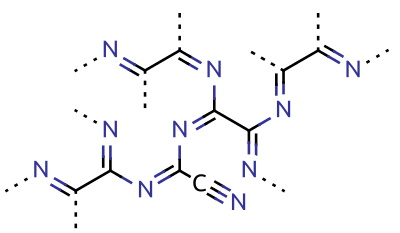|
Acetonitrile
Acetonitrile, often abbreviated MeCN (methyl cyanide), is the chemical compound with the formula and structure . This colourless liquid is the simplest organic nitrile (hydrogen cyanide is a simpler nitrile, but the cyanide anion is not classed as organic). It is produced mainly as a byproduct of acrylonitrile manufacture. It is used as a polar aprotic solvent in organic synthesis and in the purification of butadiene. The skeleton is linear with a short distance of 1.16 Å. Acetonitrile was first prepared in 1847 by the French chemist Jean-Baptiste Dumas. Applications Acetonitrile is used mainly as a solvent in the purification of butadiene in refineries. Specifically, acetonitrile is fed into the top of a distillation column filled with hydrocarbons including butadiene, and as the acetonitrile falls down through the column, it absorbs the butadiene which is then sent from the bottom of the tower to a second separating tower. Heat is then employed in the separa ... [...More Info...] [...Related Items...] OR: [Wikipedia] [Google] [Baidu] |
Aminoacetonitrile
Aminoacetonitrile is the organic compound with the formula . The compound is a colorless liquid. It is unstable at room temperature, owing to the incompatibility of the amine nucleophile and the nitrile electrophile. For this reason it is usually encountered as the chloride and bisulfate salts of the ammonium derivative, i.e., CCH2NH3sup>+Cl− and CCH2NH3sup>+HSO4−. Production and applications Industrially aminoacetonitrile is produced from glycolonitrile by reaction with ammonia: :HOCH2CN + NH3 → H2NCH2CN + H2O The aminoacetonitrile can be hydrolysed to give glycine: Being bifunctional, it is useful in the synthesis of diverse nitrogen-containing heterocycles. Aminoacetonitrile derivatives are useful antihelmintics. They act as nematode specific ACh agonists causing a spastic paralysis and rapid expulsion from the host. Occurrence in the interstellar medium Using radio astronomy, aminoacetonitrile was discovered in the Large Molecule Heimat, a giant gas cloud ... [...More Info...] [...Related Items...] OR: [Wikipedia] [Google] [Baidu] |
Glycolonitrile
Glycolonitrile, also called hydroxyacetonitrile or formaldehyde cyanohydrin, is the organic compound with the formula HOCH2CN. It is the simplest cyanohydrin and it is derived from formaldehyde. It is a colourless liquid that dissolves in water and ether. Because glycolonitrile decomposes readily into formaldehyde and hydrogen cyanide, it is listed as an List of extremely hazardous substances, extremely hazardous substance. In January 2019, astronomers reported the detection of glycolonitrile, another possible Abiogenesis, building block of life among List of interstellar and circumstellar molecules, other such molecules, in outer space. Synthesis and reactions Glycolonitrile is produced by reacting formaldehyde with hydrogen cyanide at near-neutral pH, but with small amounts of catalytic base.Peter Pollak, Gérard Romeder, Ferdinand Hagedorn, Heinz-Peter Gelbke "Nitriles" ''Ullmann's Encyclopedia of Industrial Chemistry'' 2002, Wiley-VCH, Weinheim. Glycolonitrile polymerizes und ... [...More Info...] [...Related Items...] OR: [Wikipedia] [Google] [Baidu] |
Nitrile
In organic chemistry, a nitrile is any organic compound that has a functional group. The name of the compound is composed of a base, which includes the carbon of the , suffixed with "nitrile", so for example is called " propionitrile" (or propanenitrile). The prefix '' cyano-'' is used interchangeably with the term ''nitrile'' in industrial literature. Nitriles are found in many useful compounds, including methyl cyanoacrylate, used in super glue, and nitrile rubber, a nitrile-containing polymer used in latex-free laboratory and medical gloves. Nitrile rubber is also widely used as automotive and other seals since it is resistant to fuels and oils. Organic compounds containing multiple nitrile groups are known as cyanocarbons. Inorganic compounds containing the group are not called nitriles, but cyanides instead. Though both nitriles and cyanides can be derived from cyanide salts, most nitriles are not nearly as toxic. Structure and basic properties The N−C−C geom ... [...More Info...] [...Related Items...] OR: [Wikipedia] [Google] [Baidu] |
Acrylonitrile
Acrylonitrile is an organic compound with the formula and the structure . It is a colorless, volatile liquid. It has a pungent odor of garlic or onions. Its molecular structure consists of a vinyl group () linked to a nitrile (). It is an important monomer for the manufacture of useful plastics such as polyacrylonitrile. It is reactive and toxic at low doses. Acrylonitrile is one of the components of ABS plastic (acrylonitrile butadiene styrene). Structure and basic properties Acrylonitrile is an organic compound with the formula and the structure . It is a colorless, volatile liquid although commercial samples can be yellow due to impurities. It has a pungent odor of garlic or onions. Its molecular structure consists of a vinyl group () linked to a nitrile (). It is an important monomer for the manufacture of useful plastics such as polyacrylonitrile. It is reactive and toxic at low doses. Production Acrylonitrile was first synthesized by the French chemist Charle ... [...More Info...] [...Related Items...] OR: [Wikipedia] [Google] [Baidu] |
DBNPA
2-2 dibromo-3-nitrilopropionamide (DBNPA) is a brominated acetamide Acetamide (systematic name: ethanamide) is an organic compound with the formula CH3CONH2. It is an amide derived from ammonia and acetic acid. It finds some use as a plasticizer and as an industrial solvent. The related compound ''N'',''N''-dime .... Its synonym is 2,2-Dibromo-2-carbamoylacetonitrile Alpha, alpha-Dibromo-alpha-cyanoacetamide Dibromocyanoacetamide. The physical appearance of DBNPA is an off-white solid at ambient temperatures with a mild antiseptic odor and is often sold in powder form. DBNPA is often used as an algicide, bactericide and fungicide in industrial water treatment systems and as a preservative used in the manufacture of paper, glues, coatings, enhanced oil recovery systems and metalworking. History The first documented synthesis of 2,2-dibromo-3-nitrilopropionamide (DBNPA) was carried out by Bernhard Conrad Hesse in 1896. DBNPA's practical applications were not explored until 19 ... [...More Info...] [...Related Items...] OR: [Wikipedia] [Google] [Baidu] |
Malononitrile
Malononitrile is an organic compound nitrile with the formula . It is a colorless or white solid, although aged samples appear yellow or even brown. It is a widely used building block in organic synthesis. Preparation and reactions It can be prepared by Dehydration reaction, dehydration of cyanoacetamide. This method is mainly practiced in China where environmental rules are lax. Most commonly malononitrile is produced by the gas-phase reaction of acetonitrile and cyanogen chloride: : About 20,000,000 kg are produced annually (2007). Important outlets include the synthesis of thiamine, the drug triamterene and minoxidil, and the dyes disperse Yellow 90 and disperse Blue 354. Malononitrile is relatively acidic, with a Acid dissociation constant, p''K''a of 11 in water. This allows it to be used in the Knoevenagel condensation, for example in the preparation of CS gas: Despite its relative obscurity, Malononitrile is very useful in several reactions, the prime example being a s ... [...More Info...] [...Related Items...] OR: [Wikipedia] [Google] [Baidu] |
Pivalonitrile
Pivalonitrile is a nitrile with the semi-structural formula (CH3)3CCN, abbreviated ''t''-BuCN. This aliphatic organic compound is a clear, colourless liquid that is used as a solvent and as a labile ligand in coordination chemistry A coordination complex is a chemical compound consisting of a central atom or ion, which is usually metallic and is called the ''coordination centre'', and a surrounding array of chemical bond, bound molecules or ions, that are in turn known as ' .... Pivalonitrile is isomeric with ''tert''-butyl isocyanide but the two compounds do not exist in chemical equilibrium, unlike its silicon analog trimethylsilyl cyanide. References 5 Tert-butyl compounds {{alkanederivative-stub ... [...More Info...] [...Related Items...] OR: [Wikipedia] [Google] [Baidu] |
Cyanogen Fluoride
Cyanogen fluoride (IUPAC name: carbononitridic fluoride) is an inorganic compound with the chemical formula . The molecule of this compound is linear, having the structural formula . It consists of a fluorine atom in a single bond with a carbon atom of a cyano group. It is a toxic and explosive gas at room temperature. It is used in organic synthesis and can be produced by pyrolysis of cyanuric fluoride or by fluorination of cyanogen. Synthesis Cyanogen fluoride, is synthesized by the pyrolysis of cyanuric fluoride (C3N3F3) at 1300 °C and 50 mmHg pressure; this process gives a maximum of 50% yield. Other products observed were cyanogen and . For pyrolysis, an induction heated carbon tube with an internal diameter of 0.75 inches is packed with 4 to 8 mesh carbon granules and is surrounded by graphite powder insulation and a water-jacketed shell. The cyanuric fluoride is pyrolyzed (becoming a pyrolysate) at a rate of 50g/hr, and appears as fluffy white solid collected in l ... [...More Info...] [...Related Items...] OR: [Wikipedia] [Google] [Baidu] |
Cyanogen
Cyanogen is the chemical compound with the chemical formula, formula . Its structure is . The simplest stable carbon nitride, it is a Transparency and translucency, colorless and highly toxic gas with a pungency, pungent odor. The molecule is a pseudohalogen. Cyanogen molecules are linear molecular geometry, linear, and consist of two CN groups ‒ analogous to diatomic halogen molecules, such as chlorine, Cl, but far less oxidizing. The two cyanide, cyano groups are bonded together at their carbon atoms, though other isomers have been detected. The name is also used for the CN radical, and hence is used for compounds such as cyanogen bromide () (but see also ''Cyano radical''). When burned at increased pressure with oxygen, it is possible to get a blue tinted flame, the temperature of which is about 4800°C (a higher temperature is possible with ozone). It is as such regarded as the gas with the second highest temperature of burning (after dicyanoacetylene). Cyanogen is the anhy ... [...More Info...] [...Related Items...] OR: [Wikipedia] [Google] [Baidu] |
Cyanide
In chemistry, cyanide () is an inorganic chemical compound that contains a functional group. This group, known as the cyano group, consists of a carbon atom triple-bonded to a nitrogen atom. Ionic cyanides contain the cyanide anion . This anion is extremely poisonous. Soluble cyanide salts such as sodium cyanide (NaCN), potassium cyanide (KCN) and tetraethylammonium cyanide () are highly toxic. Covalent cyanides contain the group, and are usually called nitriles if the group is linked by a single covalent bond to carbon atom. For example, in acetonitrile , the cyanide group is bonded to methyl . In tetracyanomethane , four cyano groups are bonded to carbon. Although nitriles generally do not release cyanide ions, the cyanohydrins do and are thus toxic. The cyano group may be covalently bonded to atoms different than carbon, e.g., in cyanogen azide , phosphorus tricyanide and trimethylsilyl cyanide . Hydrogen cyanide, or , is a highly volatile toxic liquid tha ... [...More Info...] [...Related Items...] OR: [Wikipedia] [Google] [Baidu] |
Acetone Cyanohydrin
Acetone cyanohydrin (ACH) is an organic compound used in the production of methyl methacrylate, the monomer of the transparent plastic polymethyl methacrylate (PMMA), also known as acrylic. It liberates hydrogen cyanide easily, so it is used as a source of such. For this reason, this cyanohydrin is also highly toxic. Preparation In the laboratory, this compound may be prepared by treating sodium cyanide with acetone, followed by acidification: : Considering the high toxicity of acetone cyanohydrin, a lab scale production has been developed using a microreactor-scale flow chemistry to avoid needing to manufacture and store large quantities of the reagent. Alternatively, a simplified procedure involves the action of sodium or potassium cyanide on the sodium bisulfite adduct of acetone prepared ''in situ''. This gives a less pure product, one that is nonetheless suitable for most syntheses. Reactions Acetone cyanohydrin is an intermediate en route to methyl methacrylate. T ... [...More Info...] [...Related Items...] OR: [Wikipedia] [Google] [Baidu] |
Polar Aprotic Solvent
A polar aprotic solvent is a solvent that lacks an acidic proton and is polar. Such solvents lack hydroxyl and amine groups. In contrast to protic solvents, these solvents do not serve as proton donors in hydrogen bonding In chemistry, a hydrogen bond (H-bond) is a specific type of molecular interaction that exhibits partial covalent character and cannot be described as a purely electrostatic force. It occurs when a hydrogen (H) atom, Covalent bond, covalently b ..., although they can be proton acceptors. Many solvents, including chlorocarbons and hydrocarbons, are classifiable as aprotic, but polar aprotic solvents are of particular interest for their ability to dissolve salts. Methods for purification of common solvents are available. References * {{Chemical solutions Solvents ... [...More Info...] [...Related Items...] OR: [Wikipedia] [Google] [Baidu] |



